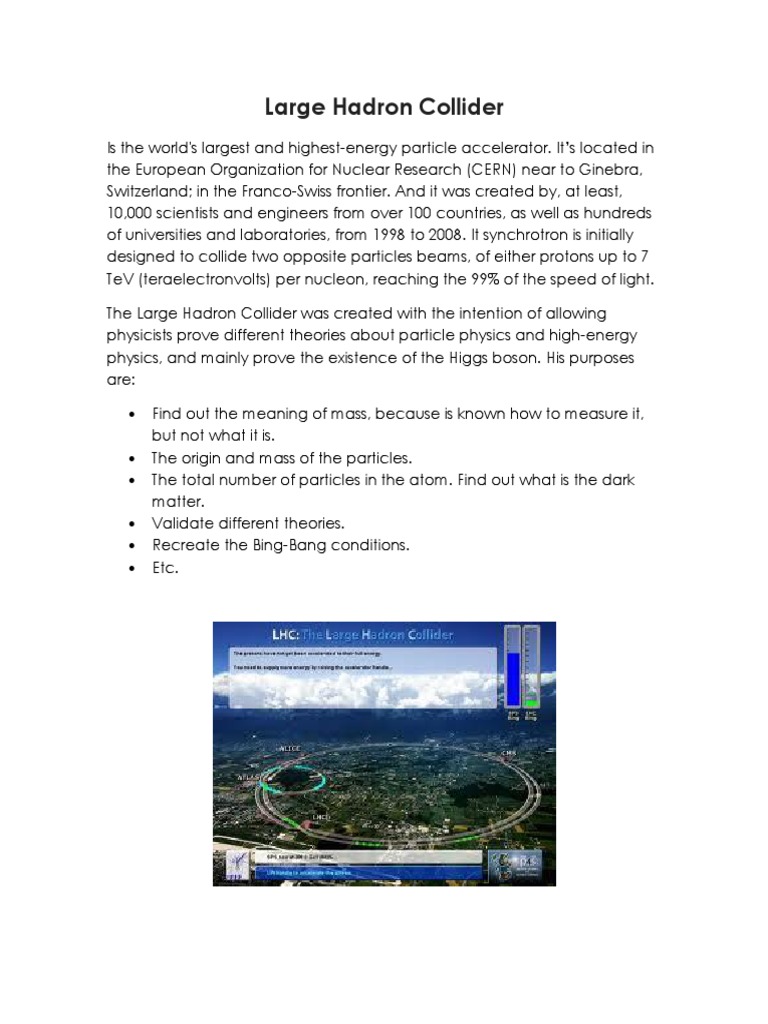The Large Hadron Collider (LHC) stands as a paragon of human ingenuity and ambition, embodying the quest to unravel the fundamental mysteries of the universe. However, this monumental scientific instrument, operational at CERN, is not without its contentious implications and associated risks. While its contributions to particle physics are profound, it also invites scrutiny concerning its safety, environmental impact, and ethical considerations. This article delves into the multifaceted risks of utilizing the LHC, providing a comprehensive examination that invites critical reflection on our scientific pursuits.
To begin, one must address the palpable concerns surrounding the production of micro-black holes. Some physicists have postulated that high-energy collisions within the LHC could theoretically generate tiny black holes. Although these entities would be minuscule and ephemeral, lasting fractions of a second, the question arises: what happens should they retain any stability? The scientific consensus is that should these elusive phenomena be generated, they would evaporate almost instantaneously through Hawking radiation. Nonetheless, the mere possibility has fueled public anxiety and bred skepticism regarding the LHC’s safety protocols.
Moreover, the concept of the “strangelet” poses another intriguing risk. In the realm of nuclear physics, strangelets are hypothetical particles containing a strange quark. Some theorists suggest that a production event at the LHC could foster the emergence of strangelets, potentially leading to a catastrophic scenario where a colony of strange matter could convert normal matter into strange matter. Although these ideas reside in the speculative domain and physicists maintain that the likelihood is exceedingly low, they beckon a reevaluation of our understanding of state transitions in subatomic entities.
Further complicating the safety narrative is the inherent nature of the LHC’s operation, which consists of driving protons to near-light speeds utilizing a cascade of electromagnetic fields. This accelerative process generates immense amounts of energy, leading to the acceleration of particles in a way that borders on the extremes of physics as we presently comprehend them. When considering the LHC’s potential to produce exotic states of matter, one might contemplate the unforeseen consequences of particle interactions occurring at energy levels that surpass any natural event recorded in cosmic history.
In addition to existential threats at the subatomic scale, the large-scale operation of the LHC necessitates a robust infrastructural framework that may not be impervious to failure. Malfunctions in cooling systems, power distribution, or data acquisition can result in hefty financial repercussions and resource wastage. The operational lifestyle, demanding precision and rigorous oversight, further presents logistical risks; human error, even of a minor degree, could cascade into significant operational failures. The implications of such malfunctions could range from minor experimental delays to major safety breaches, raising questions about the robustness of oversight mechanisms in place.
Environmental concerns also warrant consideration in the discourse regarding the LHC’s operation. The construction and maintenance of the LHC require substantial energy resources and raw materials, leading to a notable carbon footprint. As the global community grapples with the imperative of sustainability, the environmental impact of massive scientific installations becomes a contentious topic. The question then arises: is the pursuit of knowledge worth the potential degradation of our ecological systems? The ethical implications of scientific exploration, balanced against environmental stewardship, become a central nexus of debate.
Moreover, the LHC demands vast quantities of computational resources for data processing. Each proton-proton collision generates terabytes of data, necessitating significant energy consumption for its analysis. This dependence raises concerns about the efficiency of resource utilization in the name of scientific advancement. Could the resources allocated to the LHC be leveraged for more immediate societal benefits? Navigating through these ethical dilemmas necessitates a careful and thoughtful discourse among the scientific community and stakeholders alike.
The psychological ramifications and public perception of the LHC cannot be overlooked. The collider operates in a realm where abstractions collide with human fears and curiosities. As the LHC becomes the subject of conspiracy theories and sensationalist media, the dissemination of misinformation poses a tangible risk to public trust in science. The juxtaposition of fear and curiosity creates an untenable atmosphere that could thwart advancements in science and technology, necessitating heightened communication efforts from the scientific community to bridge this gap.
Ultimately, although the LHC is a beacon of scientific potential, it is crucial to confront the inherent risks associated with its operation. The conjectures around micro-black holes and strangelets, the complexities of human management of advanced technology, the environmental impact, and the socio-psychological landscape together embody a tapestry of risk that must be meticulously navigated. As we stand at the frontier of unprecedented scientific endeavors, a balanced approach – one that advocates for the pursuit of knowledge while remaining acutely aware of the implications – must guide our journey through the cosmos.
In conclusion, the LHC encapsulates a duality; on one hand, it promises unparalleled insights into the fabric of our universe, while on the other, it unveils a series of existential queries that warrant thoughtful consideration. Such a juxtaposition compels us to engage thoughtfully with our scientific endeavors and fosters a prudent discourse surrounding the myriad of risks associated with groundbreaking exploration.












